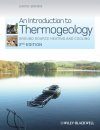![An Introduction to Thermogeology An Introduction to Thermogeology]()
Click to have a closer look
About this book
Contents
Customer reviews
Biography
Related titles
About this book
This authoritative guide provides a basis for understanding the emerging technology of ground source heating and cooling. It equips engineers, geologists, architects, planners and regulators with the fundamental skills needed to manipulate the ground's huge capacity to store, supply and receive heat, and to implement technologies (such as heat pumps) to exploit that capacity for space heating and cooling.
The author has geared the book towards understanding ground source heating and cooling from the ground side (the geological aspects), rather than solely the building aspects. He explains the science behind thermogeology and offers practical guidance on different design options. An Introduction to Thermogeology: Ground Source Heating and Cooling is aimed primarily at professionals whose skill areas impinge on the emerging technology of ground source heating and cooling. They will be aware of the importance of the technology and wish to rapidly acquire fundamental theoretical understanding and design skills.
This second edition has been thoroughly updated and expanded to cover new technical developments and now includes end-of-chapter study questions to test the reader's understanding.
Contents
About the Author xi
Preface to the First Edition xiii
Preface to the Second Edition xv
Acknowledgements xvii
1 An Introduction 1
2 Geothermal Energy 11
3 The Subsurface as a Heat Storage Reservoir 40
4 What Is a Heat Pump? 79
5 Heat Pumps and Thermogeology: A Brief History and International Perspective 114
6 Ground Source Cooling 133
7 Options and Applications for Ground Source Heat Pumps 150
8 The Design of Groundwater-Based Open-Loop Systems 202
9 Pipes, Pumps and the Hydraulics of Closed-Loop Systems 248
10 Subsurface Heat Conduction and the Design of Borehole-Based Closed-Loop Systems 279
11 Horizontal Closed-Loop Systems 325
12 Pond- and Lake-Based Ground Source Heat Systems 353
13 Standing Column Wells 372
14 Thinking Big: Large-Scale Heat Storage and Transfer 383
15 Thermal Response Testing 410
16 Environmental Impact, Regulation and Geohazards 432
References 463
Study Question Answers 493
Symbols 503
Glossary 509
Units 515
Index 518
Customer Reviews
Biography
David Banks is one of the Britain's leading hydrogeologists and has been instrumental in promoting ground source heating and cooling within the UK. He has over 26 years international experience from consultancy, the public sector, academia and commercial training. He runs his own business, Holymoor Consultancy Ltd., and has taught at the Universities of Sheffield, Leeds and Newcastle-upon-Tyne. Most recently, he has been a trainer on the EU's Geotrainet programme.


































